113 Painting Rack 5
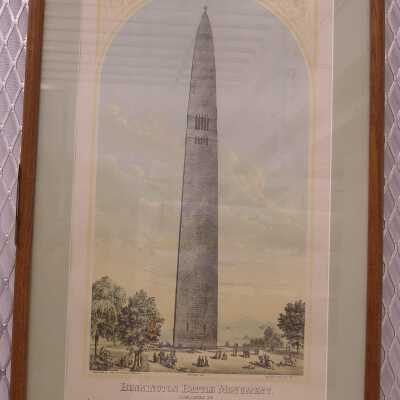

Bennington Battle Moument
Name/Title
Bennington Battle Moument
Lexicon
Description
Colored lithographic print showing the Bennington Battle monument, which is a large, gray obelisk with a series of five long, vertical windows in the center in a series of two rows the upper being longer than the lower and each row capping with a protruding gray ledge. There are several groupings of people on the ground beneath the monument, their shadows reaching towards the central structure. They are shown in fields and amongst trees as if in a park with light greenish-blue mountains in the background and a light blue sky with layers of fluffy grayish, yellowish clouds evaporating into a golden mist over the mountains. The print itself is a portrait-based image with a round top. Filling in the upper corners of the general print is a continuation of the light yellow, linear border into two delicate double and mirrored curling vine designs. Underneath the image but inside of the light, yellow, linear border in very small, black single-stroke lettering from left to right, "PUBLISHED BY WELLS & COVERLY, TROY, N.Y. COPYRIGHT 1891. BURLEIGH LITHO EST TROY, N.Y."
Under the print is the title, "BENNINGTON BATTLE MONUMENT" in empty serifed lettering delineated by stylistic, black outlining, an advertisement for a clothing store in Troy, New York, and details about the monument. Bearing inscriptions, "PUBLISHED BY," in small serifed lettering, "WELLS & COVERLY," in much larger, thin serifed lettering. Underneath in thick, dark, simplistic lettering, "The People's Popular CLOTHIERS," and below that in very thin and smaller, mono linear writing, "336-338 RIVER ST.,/13-15-17 FOURTH ST.," to the left in taller, darker, serifed lettering, "TROY, N.Y."
On either side of the main body are smaller paragraphs of inscriptions:
On the left in italicized, semi-cursive, serifed lettering, "Bennington Battle Monument Associa-/tion chartered 1853./Corner stone laid Aug. 16, '87/Cap stone placed Nov. 25th, '89/Dedicated Aug. 19, '91."
On the right side in taller, typewriter style, squarish lettering, "DIMENSIONS." Underneath in the same small, italicized, semi-cursive, serifed writing, "Base 37 ft. square./Height 301 feet." Again in taller typewriter style lettering, "COST." Undenerth in the same italicized, "Monument and grounds 117,000./Designed by J. Ph. Sinm, Boston."
Under the print is the title, "BENNINGTON BATTLE MONUMENT" in empty serifed lettering delineated by stylistic, black outlining, an advertisement for a clothing store in Troy, New York, and details about the monument. Bearing inscriptions, "PUBLISHED BY," in small serifed lettering, "WELLS & COVERLY," in much larger, thin serifed lettering. Underneath in thick, dark, simplistic lettering, "The People's Popular CLOTHIERS," and below that in very thin and smaller, mono linear writing, "336-338 RIVER ST.,/13-15-17 FOURTH ST.," to the left in taller, darker, serifed lettering, "TROY, N.Y."
On either side of the main body are smaller paragraphs of inscriptions:
On the left in italicized, semi-cursive, serifed lettering, "Bennington Battle Monument Associa-/tion chartered 1853./Corner stone laid Aug. 16, '87/Cap stone placed Nov. 25th, '89/Dedicated Aug. 19, '91."
On the right side in taller, typewriter style, squarish lettering, "DIMENSIONS." Underneath in the same small, italicized, semi-cursive, serifed writing, "Base 37 ft. square./Height 301 feet." Again in taller typewriter style lettering, "COST." Undenerth in the same italicized, "Monument and grounds 117,000./Designed by J. Ph. Sinm, Boston."
Acquisition
Accession
2006.69
Relationships
Related Places
Place
Troy
City
New York
State/Province
United States of America
Country
North America
Artwork Details
Subject
Bennington Battle Monument
Dimensions
Dimension Description
Overall
Entry/Object ID
2006.69.8
Context
Planning started for a monument to the American Revolution victory at the Battle of Bennington in the 1850s. Local officials and philanthropists hoped for the structure to be completed for the 100th anniversary of the victory in 1877. Design changes, funding difficulties, and construction delays led to a dedication in 1891, the centennial of Vermont statehood. The monument anchors the colonial neighborhood of Old Bennington in Vermont's Southwest corner. The monument, originally built and maintained by the Bennington Historical Association (now Bennington Museum), is now a state historic site.
Web Links and URLs


Burlington Harbor, ca. 1895
Name/Title
Burlington Harbor, ca. 1895
Lexicon
Description
This painting portrays a white steamboat positioned in the water, situated near the shore adjacent to a large two-story building that extends into the water. The scene is depicted from a viewpoint on the water, looking towards the shore. The land is represented as a flat strip positioned below the center line of the composition, adorned with numerous trees and buildings painted in shades of tan, red, and white. The steamboat itself features distinctive elements, including a black smokestack and a water wheel positioned on its side. It has two deck levels. The wheel cover of the water wheel bears the label "Chateaugay," while a blue flag with the same label is seen flying from the boat. At the stern, an American flag is displayed, while the bow exhibits the Vermont flag. The sky above is depicted as a blue expanse, embellished with scattered white clouds.
Acquisition
Accession
2006.45
Relationships
Related Publications
Celebrating Ernest Haas
Publication
Artwork Details
Medium
Acrylic
Subject
Steamboat Chateaugay
Made/Created
Artist Information
Haas, Ernest J. (b. 1927)
Artist
Date made
2006
Dimensions
Dimension Description
Overall
Entry/Object ID
2006.45.1
Context
Born in Albany, New York in 1927, Ernie Haas showed an early aptitude for drawing. After serving in the Navy at the end of WWII he enrolled at Paul Smith College for a year before transferring to the School of Practical Art in Boston. He was called back into service during the Korean War and was assigned to the Naval Photo Center where he produced art for training materials.
He worked for a time as an artist agent in New York before going back to school at Southern Connecticut College for a degree in history. He taught in Connecticut schools until retirement in 1984. At that time he and his wife relocated to South Burlington, Vermont.
Haas became involved as a volunteer with the Lake Champlain Maritime Museum and was encouraged to rediscover his love of painting by then director Art Cohn. Haas created original artwork for museum exhibitions and publications as well as stand-alone works of early sidewheelers and historical events.
The steamboat Chateaugay was built in 1887 at Shelburne Harbor and launched by the Champlain Transportation Company as a state-of-the-art excursion vessel. It operated for 37 years as an excursion boat before being stripped down and converted into a car ferry in 1925. The boat is depicted in its heyday departing the Lake Champlain Yacht Club in Burlington Harbor.
He worked for a time as an artist agent in New York before going back to school at Southern Connecticut College for a degree in history. He taught in Connecticut schools until retirement in 1984. At that time he and his wife relocated to South Burlington, Vermont.
Haas became involved as a volunteer with the Lake Champlain Maritime Museum and was encouraged to rediscover his love of painting by then director Art Cohn. Haas created original artwork for museum exhibitions and publications as well as stand-alone works of early sidewheelers and historical events.
The steamboat Chateaugay was built in 1887 at Shelburne Harbor and launched by the Champlain Transportation Company as a state-of-the-art excursion vessel. It operated for 37 years as an excursion boat before being stripped down and converted into a car ferry in 1925. The boat is depicted in its heyday departing the Lake Champlain Yacht Club in Burlington Harbor.
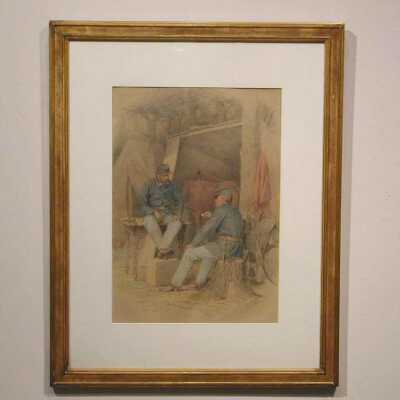

Civil War Sketch
Name/Title
Civil War Sketch
Lexicon
Description
Landscape. 2 men in uniform, sitting, one stump in foreground holding pipe, other on table with feet on box. horses eating hay in lean-to structure behind seated figures, tent among trees in background, saddle, right edge ceter.
Acquisition
Source (if not Accessioned)
Unknown
Relationships
Related Events
Civil War
Event
Related Person or Organization
3rd Vermont Infantry
Person or Organization
Artwork Details
Medium
Pencil
Subject
Civil War camp life
Made/Created
Artist Information
Scott, Julian A. (1846-1901)
Artist
Date made
1871
Dimensions
Entry/Object ID
VHS-A-166
Type of Drawing
Context
Julian A. Scott (February 14, 1846 – July 4, 1901), was born in Johnson, Vermont, and served as a Union Army drummer during the American Civil War, where he received America's highest military decoration the Medal of Honor for his actions at the Battle of Lee's Mills. He was also an American painter and Civil War artist.
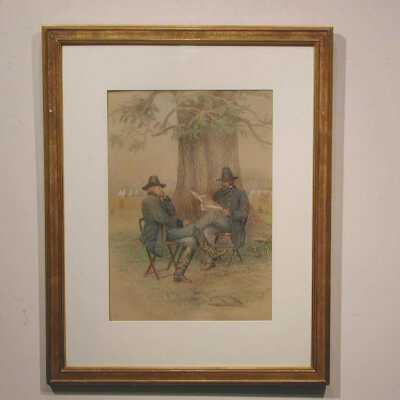

Civil War Sketch
Name/Title
Civil War Sketch
Lexicon
Description
Landscape. Large tree in center, 2 men in uniform seated in front, one man reading newspaper, camp with white tents and people in background. Branch on ground lower right corner.
Acquisition
Source (if not Accessioned)
Unknown
Relationships
Related Events
Civil War
Event
Related Person or Organization
3rd Vermont Infantry
Person or Organization
Artwork Details
Medium
Pencil, Chalk
Subject
Civil War Camp Life
Made/Created
Artist Information
Scott, Julian A. (1846-1901)
Artist
Date made
1871
Dimensions
Entry/Object ID
VHS-A-165
Type of Drawing
Context
Julian A. Scott (February 14, 1846 – July 4, 1901), was born in Johnson, Vermont, and served as a Union Army drummer during the American Civil War, where he received America's highest military decoration the Medal of Honor for his actions at the Battle of Lee's Mills. He was also an American painter and Civil War artist.
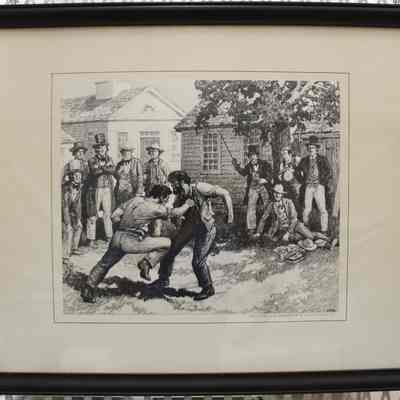

Fist Fight
Name/Title
Fist Fight
Lexicon
Description
Print of drawing commissioned by National Life Insurance Company entitle "Fist Fight."
Two men in the foreground are engaged in a fight. Two groups of men in 18th-century clothing appear in the background observing the contest. A clapboarded building and shingled building are in the background and set the scene as a townscape.
Two men in the foreground are engaged in a fight. Two groups of men in 18th-century clothing appear in the background observing the contest. A clapboarded building and shingled building are in the background and set the scene as a townscape.
Acquisition
Accession
2014.60
Artwork Details
Medium
Paper
Subject
Fight to name Barre
Made/Created
Artist Information
Heinrich, Roy Frederic (1881-1943)
Artist
Date made
1938
Dimensions
Entry/Object ID
2014.60.1322
Context
From 1934 to 1946, National Life Insurance Company embarked on a long-term marketing program that used stories from Vermont History to represent company values. A series of artists were engaged to create black and white artwork for a broad, nationwide campaign. National Life published the prints and associated stories as an educational resource for Vermont Schools. Many of the original drawings were the highlight of the Vermont Pavilion at the 1939-40 World's Fair.
This particular print depicts a fictional story, once thought as fact, of two men engaging in a fight/wrestling match for the right to name the current municipality of Barre. The area that we now know as Barre City and Barre Town was originally incorporated as Wildersburgh in 1780. In 1793 the citizens of the town voted to create a new house of worship. To raise the needed funds they offered the rights to rename the town to the person committing the most funds to the meeting house construction. Ezekiel Dodge Wheeler offered £62 and named the town Barre after Barre, Massachusetts.
This particular print depicts a fictional story, once thought as fact, of two men engaging in a fight/wrestling match for the right to name the current municipality of Barre. The area that we now know as Barre City and Barre Town was originally incorporated as Wildersburgh in 1780. In 1793 the citizens of the town voted to create a new house of worship. To raise the needed funds they offered the rights to rename the town to the person committing the most funds to the meeting house construction. Ezekiel Dodge Wheeler offered £62 and named the town Barre after Barre, Massachusetts.


Fuel
Name/Title
Fuel
Lexicon
Description
Black and white woodcut depicting a central female figure with a wagon at her feet holding an armload of wood. Two automobiles are at the left and another figure to the right. A large structure with clearstory is in the background.
Titled "Fuel" and signed by the artist in pencil.
Titled "Fuel" and signed by the artist in pencil.
Acquisition
Accession
2007.36
Relationships
Related Publications
Ronald Slayton
Publication
Artwork Details
Medium
Paper, Ink
Made/Created
Artist Information
Slayton, Ronald Alfred (1910-1992)
Artist
Date made
1936
Dimensions
Entry/Object ID
2007.36.1
Context
Ronald Slayton (1910-1992) was born in Barre. During the Great Depression, he worked as an artist in the Vermont Division of the federally-funded Works Progress Administration (WPA) from 1936-1939. W.C. Lipke once commented that Slayton “has been a painter, poet, dramatist, educator, politician, gallery director, peace activist, humorist, critic and historian suggest that the single appellation ‘artist’ is not broad enough to encompass his many achievements.”
This particular woodcut was created during his first year working for the Federal Art Project as an easel artist. This print was exhibited in a 1989 exhibition of his work at the T.W. Wood Gallery in Montpelier. To accompany the work, Slayton offered the following poem:
There was a hunger and
They were fed by soil's bounty.
There was a thirst for water
And water was there in all living things,
A remnant of sea left in themselves
There was darkness, then as now,
Soft upon the island hills at dusk;
Night, a same black ocean, swept the valleys
To wane before their feeble fire.
This particular woodcut was created during his first year working for the Federal Art Project as an easel artist. This print was exhibited in a 1989 exhibition of his work at the T.W. Wood Gallery in Montpelier. To accompany the work, Slayton offered the following poem:
There was a hunger and
They were fed by soil's bounty.
There was a thirst for water
And water was there in all living things,
A remnant of sea left in themselves
There was darkness, then as now,
Soft upon the island hills at dusk;
Night, a same black ocean, swept the valleys
To wane before their feeble fire.
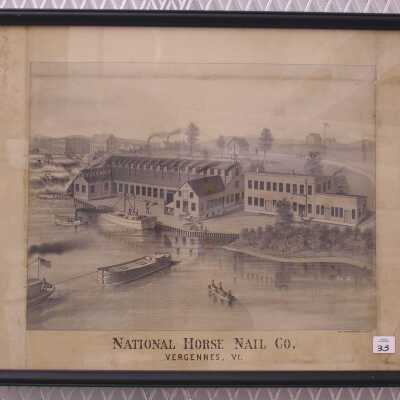

National Horse Nail Company
Name/Title
National Horse Nail Company
Lexicon
Description
Lithographic print showing 2 large factory buildings beside a body of water. There is a large boat pulled alongside the quay, a small steamboat near it, 2 large boats directly approaching the shore, and a small rowboat. Behind the factories are a waterfall (left), 2 factory buildings, and scattered domestic buildings. Beneath the print is the title, "National Horse Nail Co. / VERGENNES, Vt." The bottom right corner is labeled, "Geo. H. WALKER & CO. Lith. BOSTON."
Acquisition
Accession
2006.69
Relationships
Related Person or Organization
National Horse Nail Company
Person or Organization
Related Places
Place
Vergennes
City
Addison County
County
Vermont
State/Province
United States of America
Country
North America
Artwork Details
Made/Created
Date made
circa 1870
Manufacturer
Geo. H. Walker & Co.
Dimensions
Dimension Description
Overall
Entry/Object ID
2006.69.7
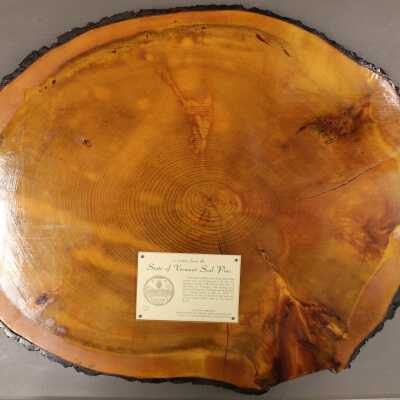

Relic, Historic
Name/Title
Relic, Historic
Lexicon
Description
Section of State of Vermont Seal Pine. Varnished and has two hanging devices nailed onto back. A paper label is covered with plexiglass and is nailed onto the front of the wood section.
Written on plaque on the tree: "A section from the State of Vermont Seal Pine. The Eastern White Pine from which this section was cut is believed to be the tree depicted on the 1779 official State Seal of the State of Vermont. The ancient tree grew in Arlington, Vemont and was felled by a strong wind on May 9, 1978. It measured six feet in diameter and was one of the largest white pines in the United States. State of Vermont Department of Forests, Parks and Recreation Agency of Environmental Conservation.
Written on plaque on the tree: "A section from the State of Vermont Seal Pine. The Eastern White Pine from which this section was cut is believed to be the tree depicted on the 1779 official State Seal of the State of Vermont. The ancient tree grew in Arlington, Vemont and was felled by a strong wind on May 9, 1978. It measured six feet in diameter and was one of the largest white pines in the United States. State of Vermont Department of Forests, Parks and Recreation Agency of Environmental Conservation.
Acquisition
Accession
1979.7
Relationships
Related Person or Organization
Allen, Ira (1751-1814)
Person or Organization
Made/Created
Date made
1978
Dimensions
Materials
Material
Wood
Entry/Object ID
1979.7.2
Context
The State Seal Pine was an eastern white pine tree that grew near Governor Thomas Chittenden's first Vermont home in Arlington. The tree was toppled by high winds in 1978 and replaced with a new white pine sapling by Governor Richard Snelling in 1979.
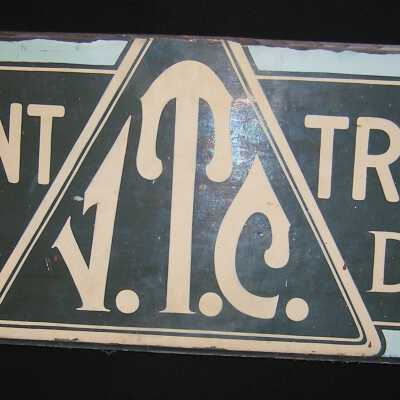

Sign
Name/Title
Sign
Lexicon
Description
Wooden "Vermont Transit (in evenly thick yet simplistic lettering)/ Bus Depot"(in stylized thick stroke lettering) "V.T.C." (in painted looking letters, melting into the shape of the triangle with drip-looking curls and accentuated points) sign, top of center triangle is missing. Dark green with aqua blue/green/cream colored multi-band border around edge. Lettering painted in cream color. Screw eyes screwed into top edge for hanging.
Acquisition
Accession
2013.29
Made/Created
Date made
1945-1955
Dimensions
Materials
Material
Wood, Metal
Entry/Object ID
2013.29.1
Context
Vermont Transit Company, later Vermont Transit Lines, was founded in 1929 by William Appleyard and served the route between Burlington and Barre, Vermont. It ultimately expanded to serve most of the state of Vermont with service to Boston, Montreal, and Portland, Maine. The line was acquired by Greyhound Lines in 1975, but retained its name and livery until 2008.
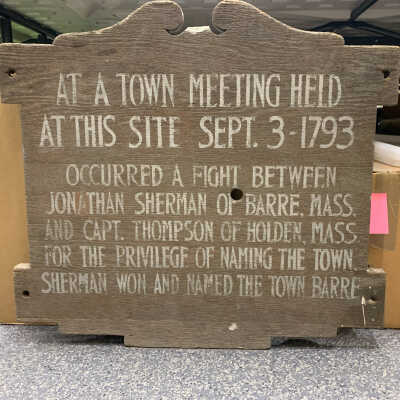

Sign
Name/Title
Sign
Description
Wooden sign with a scrolled top. The sign is painted with the inscription, "AT A TOWN MEETING HELD AT THIS SITE SEPT. 3-1793 OCCURRED A FIGHT BETWEEN JONATHAN SHERMAN OF BARRE, MASS. AND CAPT. THOMPSON OF HOLDEN, MASS. FOR THE PRIVILEGE OF NAMING THE TOWN. SHERMAN WON AND NAMED THE TOWN BARRE". There are tabs extending to the side at the top and bottom corners of both sides, each with a hole drilled through the center. There is a large round hole near the center of the side over the "F" of the word "OF".
Acquisition
Accession
2021.41
Dimensions
Entry/Object ID
2021.41.1
Context
The legend conveyed on this old historical marker made for a good story and was often repeated in history books. The actual history is a bit more tame. The area that we now know as Barre City and Barre Town was originally incorporated as Wildersburgh in 1780. In 1793 the citizens of the town voted to create a new house of worship. To raise the needed funds they offered the rights to rename the town to the person committing the most funds to the meeting house construction. Ezekiel Dodge Wheeler offered £62 and named the town Barre after Barre, Massachusetts.


The Welden House
Name/Title
The Welden House
Lexicon
Description
Print showing a large white building with several groupings of people in the foreground. The building is 6 stories tall, 9 bays wide, and 6 bays deep. Beneath the print is the title, "WELDEN HOUSE. ST. ALBANS, VT." and information about the hotel within the building.
Acquisition
Accession
2006.69
Artwork Details
Subject
Welden House Hotel
Made/Created
Artist Information
Newcomb, J.
Artist
Date made
1870-1897
Manufacturer
Bufford's Lithography
Dimensions
Dimension Description
Overall
Entry/Object ID
2006.69.2
Context
The Welden House, developed by Elinus J. Morrison, was in the process of being built at the time of the St. Albans Raid. Morrison was walking on Main Street and was shot by the Confederate raiders, the only fatality of this northernmost raid of the Civil War.
The finished hotel was the finest in St. Albans and featured 200 rooms, gas and electric lighting, steam heat, electric call bells, and an Otis elevator. A large interior courtyard allowed natural light into all rooms. In addition to the hotel, the building also housed a U.S. Post Office, Western Union telegraph office, restaurant, theater, billiards hall, and livery stable.
It was destroyed by fire on July 17, 1897.
The finished hotel was the finest in St. Albans and featured 200 rooms, gas and electric lighting, steam heat, electric call bells, and an Otis elevator. A large interior courtyard allowed natural light into all rooms. In addition to the hotel, the building also housed a U.S. Post Office, Western Union telegraph office, restaurant, theater, billiards hall, and livery stable.
It was destroyed by fire on July 17, 1897.
Web Links and URLs
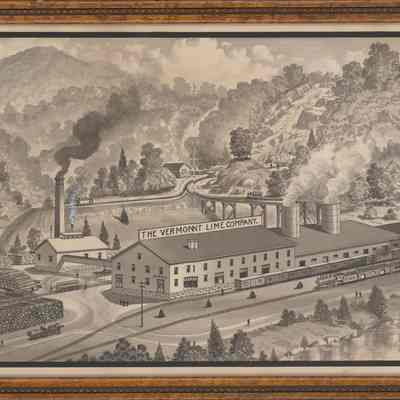

Vermont Lime Company
Name/Title
Vermont Lime Company
Lexicon
Description
This artwork is a watercolor and ink drawing depicting an industrial scene. At the center of the composition stands a large industrial building or factory, distinguished by a prominent sign on its roof peak that reads "THE VERMONT LIME COMPANY." This building is connected to a shorter factory structure, characterized by two substantial chimneys or smokestacks. In the foreground, parallel to the factory, two railroad tracks are depicted, with trains positioned along them. Towards the bottom right corner, a river flows. On the left side of the composition, piles of timber can be seen. In the background, the horizon is marked by rolling hills. The railroad tracks form a bridge leading into the hills.
Acquisition
Accession
2005.30
Relationships
Related Person or Organization
The Vermont Lime Company
Person or Organization
Artwork Details
Medium
Watercolor
Subject
Vermont Lime Company
Made/Created
Date made
1910-1913
Dimensions
Entry/Object ID
2005.30.1
Type of Drawing
Context
The Vermont Lime Company operated in Whitingham, Vermont from 1910 to 1913.